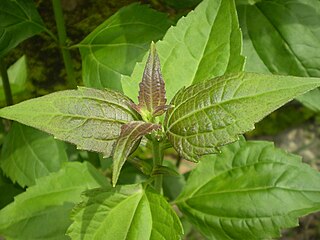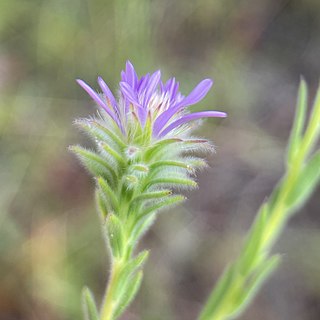
Eupatorium is a genus of flowering plants in the family Asteraceae, containing from 36 to 60 species depending on the classification system. Most are herbaceous perennials growing to 0.5–3 m (1.6–9.8 ft) tall. A few are shrubs. The genus is native to temperate regions of the Northern Hemisphere. Most are commonly called bonesets, thoroughworts or snakeroots in North America. The genus is named for Mithridates Eupator, king of Pontus.

Chromolaena odorata is a tropical and subtropical species of flowering shrub in the family Asteraceae. It is native to the Americas, from Florida and Texas in the United States south through Mexico and the Caribbean to South America. It has been introduced to tropical Asia, West Africa, and parts of Australia.

Eupatorium altissimum, with the common names tall thoroughwort and tall boneset, is a perennial herbaceous plant in the Asteraceae family with a native range including much of the eastern and central United States and Canada. It is a tall plant found in open woods, prairies, fields, and waste areas, with white flowers that bloom in the late summer and fall.

Chromolaena is a genus of about 165 species of perennials and shrubs in the family Asteraceae. The name is derived from the Greek words χρῶμα (khrôma), meaning "color", and χλαῑνα (khlaīna) or λαῑνα (laīna) meaning "cloak". It refers to the colored phyllaries of some species. Members of the genus are native to the Americas, from the southern United States to South America. One species, Chromolaena odorata, has been introduced to many parts of the world where it is considered a weed.

Eupatorium resinosum, the pine barren thoroughwort, is a rare North American plant species in the family Asteraceae.

Arnoglossum album, the Bay County Indian plantain, is a rare Florida species of plants in the family Asteraceae, first described to modern science in 1998. It has been found only in Bay and Gulf Counties in the Florida Panhandle.
Asanthus squamulosus is a North American species of plants in the family Asteraceae. It is native to northern Mexico, and the southwestern United States. Common name is Mule Mountain false brickellbush.

Balduina atropurpurea, the purpledisk honeycombhead, is a North American species of plants in the sunflower family. It is native to the southeastern United States.
Boltonia apalachicolensis, common name Apalachicola doll's-daisy, is a North American species of plants in the family Asteraceae. It is found in the "panhandle" region of northwestern Florida, and has been found in south Louisiana, and Mississippi in the United States.

Chromolaena ivifolia called ivy-leaf false thoroughwort, or ivyleaf thoroughwort, is a species of flowering shrub in the family Asteraceae. It is native to North America and South America, from the south-eastern United States to Argentina.
Chromolaena bigelovii called Bigelow's false thoroughwort, or Bigelow's thoroughwort, is a North American species of flowering shrub in the family Asteraceae. It is native to northeastern Mexico and the US State of Texas.
Chromolaena borinquensis, the limestone thoroughwort, is a West Indian species of flowering shrub in the family Asteraceae. It is native to the Commonwealth of Puerto Rico, part of the United States.
Chromolaena geraniifolia, the geraniumleaf thoroughwort, is a West Indian species of flowering shrub in the family Asteraceae. It is native to the Commonwealth of Puerto Rico, part of the United States.
Chromolaena oteroi, commonly known as the Mona Island thoroughwort, is a species of flowering shrub in the family Asteraceae. It has been found only on Mona Island, a small island between Puerto Rico and Hispaniola in the West Indies and politically a part of the Commonwealth of Puerto Rico.

Conoclinium betonicifolium, the betony-leaf mistflower or betonyleaf thoroughwort, is a North American species of flowering plants in the family Asteraceae. It is widespread across much of Mexico from Chihuahua to Quintana Roo, and has also been found in Texas and Guatemala.
Coreopsis integrifolia, the fringeleaf tickseed or mouse-ear tickseed, is a North American plant species of the family Asteraceae. It is native to the southeastern United States, in South Carolina, Georgia, and northern Florida.

Fleischmannia incarnata, the pink slender-thoroughwort or pink thoroughwort, is a North American species of flowering plant in the family Asteraceae. It is native to the United States from Florida north as far as Virginia, Ohio, and Illinois, and west to Texas and Oklahoma. It is also found in northeastern Mexico.
Fleischmannia sonorae, the Sonoran slender-thoroughwort or Sonoran thoroughwort, is a North American species of flowering plant in the family Asteraceae. It is native to western Mexico from Sonora and Chihuahua as far south as Michoacán, as well as from the southwestern United States.

Koanophyllon villosum, the Florida Keys thoroughwort, or abre camino, is a species of flowering plant in the family Asteraceae. It grows in southern Florida, Cuba, the Bahamas, Hispaniola, Jamaica, and the Islas de la Bahía.

Symphyotrichum plumosum is a species of flowering plant in the family Asteraceae endemic to Florida in the United States. Commonly known as plumose aster, it is a perennial, herbaceous plant that may reach 40 to 100 centimeters tall. Its flowers have rose-purple ray florets and yellow turning to purple disk florets. It is of conservation concern.












